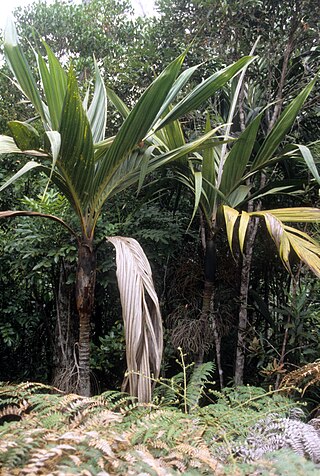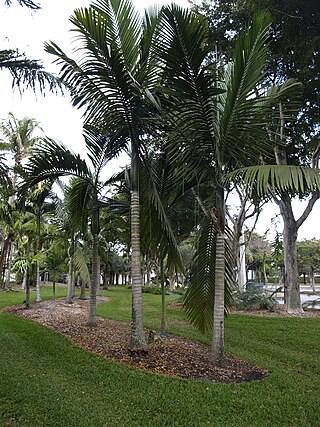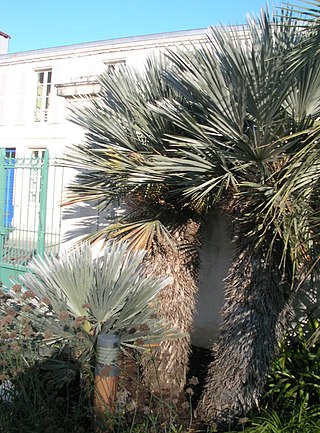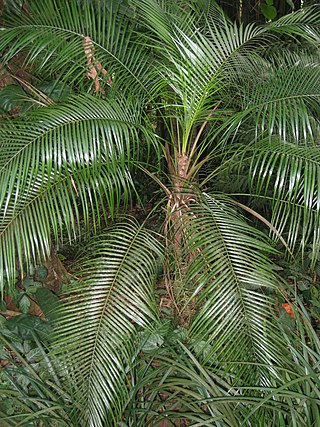
Phoenix is a genus of 14 species of palms, native to an area starting from the Canary Islands in the west, across northern and central Africa, to the extreme southeast of Europe (Crete), and continuing throughout southern Asia, from Anatolia east to southern China and Malaysia. The diverse habitats they occupy include swamps, deserts, and mangrove sea coasts. Most Phoenix species originate in semi-arid regions, but usually occur near high groundwater levels, rivers, or springs. The genus is unusual among members of subfamily Coryphoideae in having pinnate, rather than palmate leaves; tribe Caryoteae also have pinnate or bipinnate leaves.
Roystonea altissima is a species of palm which is endemic to hillsides and mountain slopes near the interior of Jamaica. The name altissima is Latin for "highest", however they are not the tallest species in the genus Roystonea. They are usually found just over sea-level to 760 metres (2,490 ft) in elevation.

Archontophoenix is a plant genus comprising six palm species that are native to New South Wales and Queensland in eastern Australia. They are tall, slender and unbranched. Relationships between Archontophoenix and the other genera of subtribe Archontophoenicinae, including the New Caledonia endemic Actinokentia, Chambeyronia and Kentiopsis are unresolved.

Actinokentia is a genus of flowering plants in the family Arecaceae, comprising two species, both indigenous to New Caledonia. Relationships between Actinokentia and the other genera of subtribe Archontophoenicinae, including the Australian Archontophoenix and the New Caledonia endemic Chambeyronia and Kentiopsis are unresolved.

Basselinia is a genus of flowering plant in the family Arecaceae. The entire genus is endemic to the Island of New Caledonia in the Pacific. In some molecular phylogenetic analyses, Hedyscepe from Lord Howe Island is nested in Basselinia.

Cyphophoenix is a genus of flowering plant in the family Arecaceae. It contains 4 known species, all endemic to New Caledonia. The relationships between Cyphophoenix and some other genera of the tribe Basseliniinae including Physokentia and the New Caledonia endemic Burretiokentia are not clear.

Hedyscepe canterburyana, the big mountain palm or umbrella palm, is the sole species in the genus Hedyscepe of the family Arecaceae. It is endemic to Lord Howe Island, Australia and is threatened by habitat loss. It is a solitary palm with a distinct crownshaft, and bears unisexual flowers of both sexes. With the Rhopalostylis palms of Norfolk Island and New Zealand it forms the botanic subtribe Rhopalostylidinae. If differs from Rhopalostylis in minor floral details including having more than six stamens, and in being protandrous rather than protogynous. The two genera were formerly included in Archontophoenicinae until a recent revision. In some molecular phylogenetic analyses, Hedyscepe was found to be nested in the New Caledonia endemic Basselinia.

Kentiopsis is a genus of palm trees endemic to New Caledonia. Relationships between Kentiopsis and the other genera of subtribe Archontophoenicinae, including the Australian Archontophoenix and the New Caledonia endemic Chambeyronia and Actinokentia are unresolved.
Clinosperma macrocarpa is a species of palm tree known from a single population at around 500 metres (1,600 ft) altitude on Mont Panié, New Caledonia. It was described as the only species in the genus Lavoixia, but has since been moved to genus Clinosperma. It is listed as critically endangered on the IUCN Red List.

Cyphokentia cerifera is a species of palm tree endemic to New Caledonia. It was previously placed the genus Moratia.
Physokentia is a genus of flowering plant in the palm family, native to certain islands of the western Pacific.

Trithrinax is a genus of flowering plants in the subfamily Coryphoideae of the family Arecaceae. The name is derived from ancient Greek, where tri means three, and thrinax trident. It was named in 1837 by Carl Friedrich Philipp von Martius, a German botanist and explorer.

Burretiokentia is a genus of palms (Arecaceae) endemic to New Caledonia containing five species. The relationships between Burretiokentia and some other genera of the tribe Basseliniinae including Physokentia and the New Caledonia endemic Cyphophoenix are not clear.
Clinosperma bractealis is a species of palm tree in the palm family

Dictyosperma is a monotypic genus of flowering plant in the palm family found in the Mascarene Islands in the Indian Ocean. The sole species, Dictyosperma album, is widely cultivated in the tropics but has been farmed to near extinction in its native habitat. It is commonly called princess palm or hurricane palm, the latter owing to its ability to withstand strong winds by easily shedding leaves. It is closely related to, and resembles, palms in the genus Archontophoenix. The genus is named from two Greek words meaning "net" and "seed" and the epithet is Latin for "white", the common color of the crownshaft at the top of the trunk.
Cyphokentia macrostachya is a species of palm endemic to New Caledonia.

Laccospadix is a monotypic plant genus in the palm family which is endemic to Queensland, Australia. The sole described species is Laccospadix australasicus, commonly called Atherton palm or Queensland kentia. The two Greek words from which it is named translate to "reservoir" and "spadix".

Leopoldinia is a mostly monoecious genus of flowering plant in the palm family from northern South America, where they are known as jará palm or pissava palm. The two known species are commercially important, especially L. piassaba, which yields sustenance and construction material. The genus is named for Maria Leopoldina, archduchess of Austria, and Brazilian empress.

Lytocaryum is a monoecious genus of flowering plant in the palm family endemic to the Atlantic coast of Brazil, where 4 species are known. Palms once classified as Microcoelum are herein included; the genus is closely related to Syagrus, from which it is differentiated only by abundant tomentum, strongly versatile anthers, and slight epicarp, mesocarp, and endocarp differences. The name is Greek for "loose" and "nut".
Clinosperma is a palm tree genus in the family Arecaceae.














